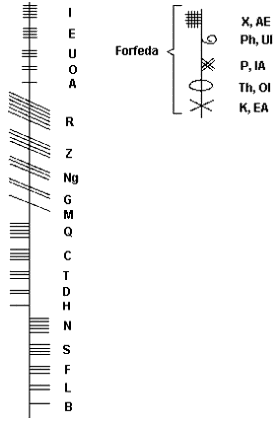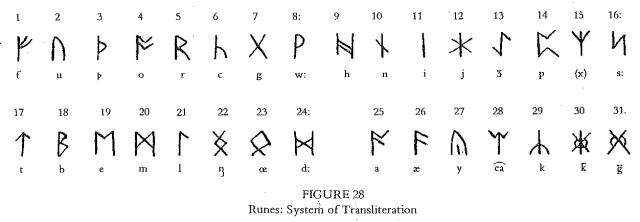I saw a facebook ap recently called “Celtic Runes”. A friendly note from a frustrated medievalist: I know runes are all mysterious and such (a PSA for another day), and so are the Celts (ditto), but there is no such thing as a Celtic rune.
The system of writing used in Ireland (which, I assume, were the Celts Facebook had in mind) was Ogham, which is actually really cool. It uses strokes oriented around a medial line:

Since this alphabet was mostly used for inscriptions on stone, the medial line was usually the edge of a monument.
Runes were used by continental German tribes, the Norse (so in Denmark, Norway, Sweden (?), Iceland, and Greenland mostly), and Anglo-Saxon England. They could have magical associations, but they were mostly just a normal alphabet for writing a language (Old Norse or Old English, as the case may be). This is the Old English one:
 [Runes from Cramp et al., Corpus of Anglo-Saxon Stone Sculpture volume I]
[Runes from Cramp et al., Corpus of Anglo-Saxon Stone Sculpture volume I]

Hungarian script !!
Was Hungarian script similar? In which period? It must have been much later than at least the start of Ogham, no?
Well, as we are descendant of the Huns, our script is very old too. There will be familiar signs , but with very diffrent meaning.http://www.omniglot.com/writing/hungarian_runes.htm
Thanks, Norbert! I had no idea. This alphabet was used for manuscripts as well, I’m assuming?
There are many objects with runes found in the celtic necropolis and archeological sites all over the continent, even in places where the germans or the norses never were, or never were before the romans. When the romans went to Gaul (France) and to Iberia (Spain), the rune inscriptions already existed, and that’s what the roman texts say, so it’s not a legend, it’s history. And as far as the gauls and the celtiberians were celtics, and not germans nor norses, I assume that was their way of writting. Here you can see an old celtiberian document where you can appreciate the same runes too: http://titus.uni-frankfurt.de/didact/idg/kelt/keltibbs.htm
The fact that any other people as germanics or northmen knew them, doesn’t mean they weren’t celtic. It only means that some languages wich hadn’t any wrote expression adopted them, the same way as english adopted the latin alphabet after, and it doesn’t mean the latin alphabet is anglo-saxon.
So, if the runes are celtic… maybe the ogham (wich a very interesting writing) is not celtic, or is a derivation of the original one, as many irish traditions wich they use to claim as celtic, and wich are not, as, for exemple, the fairies, wich are the former greek driads, or the leprechauns, inherited both from the roman empire and its greek heritage. Please, remember the celts were not the only people who arrived to those islands… many others lived there and they brough their traditions too. Don’t delete them just because some people wants to mark the difference with the british empire. Remember the celtic league is a political group to make front to Great Britain, and many of the myths about the celts come from the need of marking the difference of Ireland, Wales and Scottland against the british, arguing cultural and historical differences, only for political reasons.
If the archeological celtic sites in the continent have runes, and the irish not, is much probably because the irish writting is not celtic, or it’s a derivation from the original one: the runes.
At last the greek word “keltoi” (celt) talked about the some barbarian tribes of the continent: people who didn’t believe in the four leaf clover, they didn’t worn in green… but they were celts. From Asia to Europe, it was a long way, and a lot of people to reduce them only to a few lands beyond the Channel. Irish are celts, but not the only ones. There are many cultural and archeological prints in Hungary, Germany, Slovakia, France, Spain, Italy, Holland, Switzerland, Poland, Portugal… runes are an exemple of their deep influence.